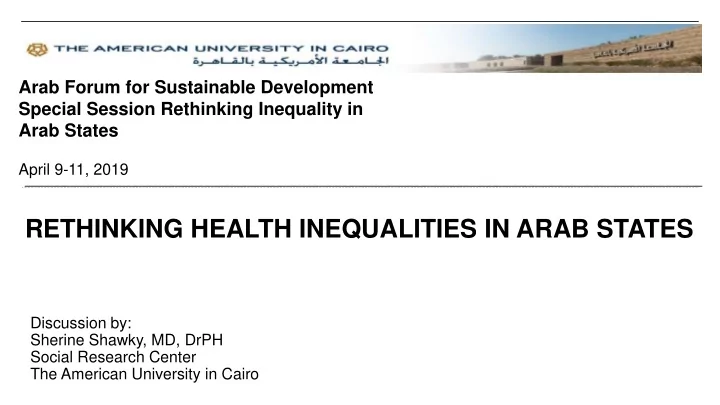

Arab Forum for Sustainable Development Special Session Rethinking Inequality in Arab States April 9-11, 2019 RETHINKING HEALTH INEQUALITIES IN ARAB STATES Discussion by: Sherine Shawky, MD, DrPH Social Research Center The American University in Cairo
OUTLINE General comments on the regional and global uptake of SDGs 1 Regional evidence on health inequalities 2 The challenges hindering progress 3 Future directions for achieving the SDGs 4
REGIONAL FACTS • Narrow vision for health “SDG3, HEALTH SECTOR, PREVENTIVE/CURATIVE PATIENT- CENTERED CARE” • Monitoring national progress uses overall averages and if disparities are displayed, the focus is on “INEQUALITIES” and not on “INEQUITIES” • The difference between “HEALTHCARE EQUITY” and “HEALTH EQUITY” is invisible • Prevailing “SYMPTOMATIC - BANDAGE POLICIES” to alleviate burden rather than “REVAMPING POLICIES” to prevent different manifestations of injustice
GLOBAL FACTS • Health is at the heart of the SDGs • “ LEAVING NO ONE BEHIND ” is not synonymous with “ EQUITY ” unless fairness is integrated • Ill-health is a manifestation of the negative impact of policies and “ HEALTH IN ALL POLICIES ” is indorsed • Two dimensions of FAIRENESS o Structural upstream policies (TRANSFORMATIVE POLICIES, TOP of TO DO LIST) o Curative policies responsive to higher burdens in disadvantaged groups • But, o SDG10 “ REDUCE INEQUALITY WITHIN AND AMONG COUNTRIES ” has no specific targets or tools o Literature has multiplicity of conceptual framing and tools
EFFORTS OF UNFPA/ASRO, WHO/EMRO AND SRC/AUC • Unite on one common vision • Use different entry points but compliment one another • Devote efforts to engage national partners: o National Population Council in Egypt, o Higher Population Council in Jordan o National Observatory for Human Development in Morocco o Ministry of Health in Oman o National Population Council in Sudan • Emphasis on “ GOVERNANCE ” , “ INTERSECTORAL ACTION ” , “ STRUCTURAL CAUSES OF ILL HEALTH ” • Health is not used as one dimension of multidimensionality but as litmus test of “ FAIRNESS ”
EFFORTS OF UNFPA/ASRO, WHO/EMRO AND SRC/AUC • Identifying health priorities : o Health: overall averages o Health system performance: negative coverage o Health system capacity: inaccessibility, unavailability, unaffordability • Identifying priorities in health inequalities: o Population stratification: geographic/administrative, wealth, gender o Measuring magnitude of inequality: (index of dissimilarity %, concentration index redistribution need %) • Geographic/administrative trend : overall averages and inequality magnitude • Identifying structural causes : decomposition analysis of root causes of ill-health
EFFORTS OF UNFPA/ASRO, WHO/EMRO AND SRC/AUC • Data sets may be out dated, are not always comprehensive, consistent and do not always allow for monitoring trend • Priority health conditions are not necessarily priority health inequalities • Successful coverage does not always mean fair distribution of services • The disfavored are not always the poor and in rural settings • Females and males have different geographic and wealth inequality patterns • The progress in the health does not always mean progress in health inequality • The role of the health system is key, but “OTHER SECTORS’ ROLES CANNOT BE LEFT BEHIND”
CHALLENGES HINDERING PROGRESS • The understanding of the SDGs and specifically “ EQUITIES ” and not “ EQUALITIES ” • The lack of standard scientific approach for achieving the SDGs • The many challenges in the region “ WHO ARE THE DISFAVORED ” , “ WHAT ARE THE HEALTH RELATED DISASTERS ” and “ WHAT ABOUT THE PEOPLE-ON- MOVE ” • The dichotomy ratio between “ Most Deprived ” and “ Most Privileged ” is not the aspired inequality measure • The information systems are not always available and if available are out dated or data sharing is not allowed • Capacities are not always competent to produce, interpret and use evidence
FUTURE DIRECTIONS FOR ACHIEVING THE SDGS • Adopt a “ WHOLE-OF-GOVERNMENT-SOCIETY APPROACH ” and use health as a sensitive measure of “ FAIRENESS ” • Build national, regional and international partnerships • Agree on conceptual framing and list of indicators and social stratification relevant to the region to link inequalities in health to the structural root economic, social, environmental, political and cultural context and allow for applying an EQUITY LENS • Strengthening information systems for health • Building capacities to steer national production and uptake translation of evidence
THANK YOU
Recommend
More recommend